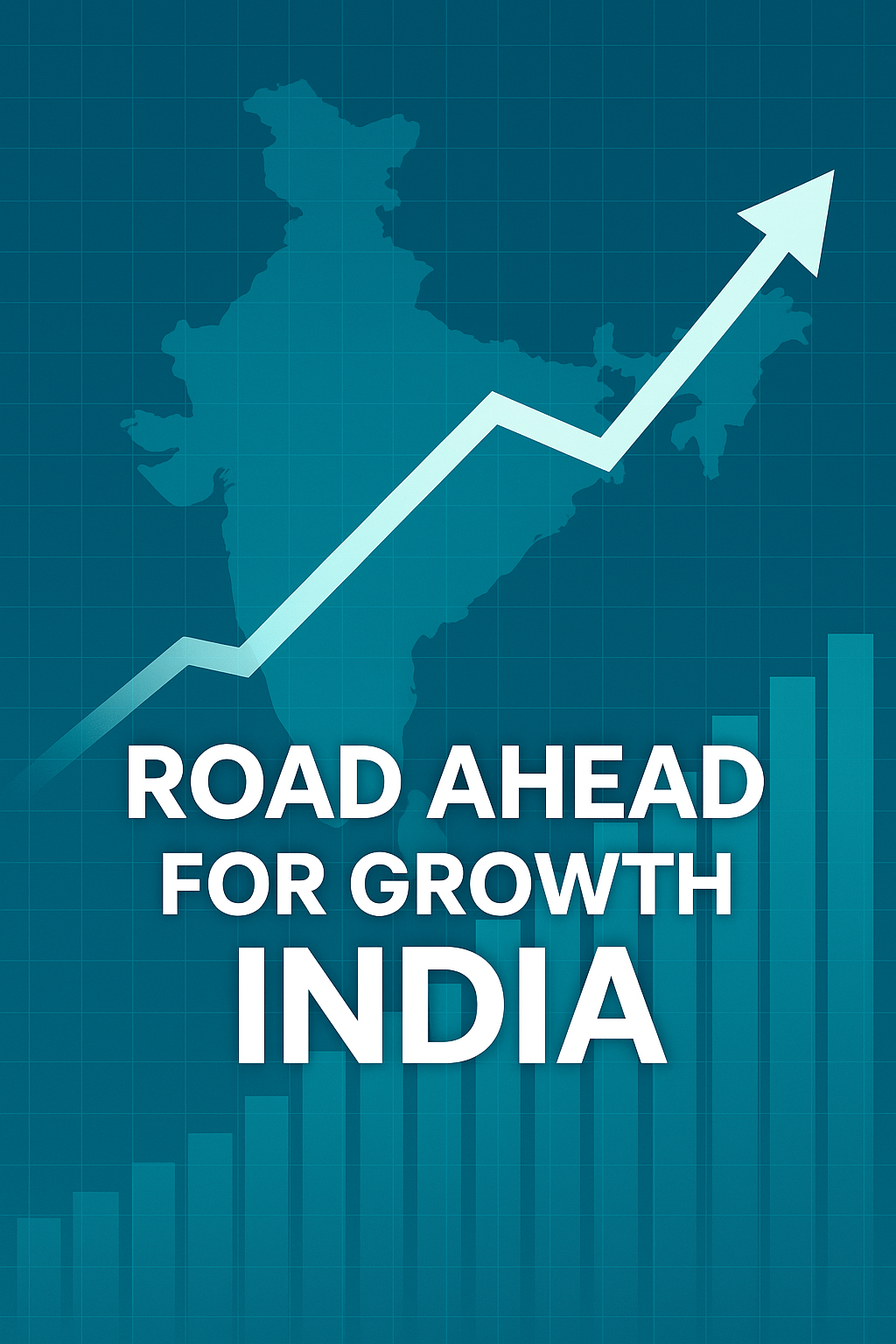Navigating the Future: Key Drivers of India’s Growth Story
India’s Economic Renaissance: Charting the Path Forward India stands at the threshold of a transformative era, where innovation, policy reforms, and economic resilience converge to shape its future. As the nation navigates global uncertainties and domestic challenges, the next phase of growth demands a strategic vision that balances sustainability, inclusivity, and technological advancement. The Reserve Bank of India's evolving monetary policy, coupled with structural shifts across industries, will play a defining role in driving economic expansion. This blog explores the road ahead, highlighting key trends, opportunities, and the strategies that will propel India toward its vision of a $5 trillion economy.
Nagarjun
6/7/20253 min read


Broad-based moderation, in the context of the Reserve Bank of India (RBI), refers to a widespread easing of inflationary pressures across various sectors of the economy. This means that price increases are slowing down not just in a few areas but across multiple categories, including core inflation, commodities, and services.
Recently, the RBI noted signs of broad-based moderation in inflation, which contributed to its decision to shift its monetary policy stance from accommodative to neutral. This change indicates that while the central bank is still mindful of supporting economic growth, it is also ensuring inflation remains under control without excessive stimulus. The moderation in inflation has been supported by factors such as easing international commodity prices and expectations of a global economic slowdown.
Broad-based moderation in inflation affects both businesses and consumers in several ways:
Impact on Businesses
Lower Input Costs: Companies benefit from reduced raw material and operational expenses, improving profit margins.
Stable Pricing Power: With inflation cooling, businesses can maintain competitive pricing without frequent cost adjustments.
Improved Investment Climate: Lower inflation can lead to favorable lending rates, encouraging companies to expand and invest.
Better Consumer Demand: As inflation stabilizes, purchasing power improves, driving demand for goods and services.
Impact on Consumers
More Affordable Goods and Services: Prices of everyday essentials, like food and fuel, may not rise as rapidly, easing cost-of-living pressures.
Higher Savings Potential: Lower inflation means households may spend less on necessities and save or invest more.
Steady Loan and Mortgage Rates: If the RBI maintains a neutral stance, interest rates may remain steady, benefiting borrowers.
Greater Financial Planning Certainty: Consumers can plan expenses and investments more confidently without worrying about unpredictable price surges.
This moderation indicates a stable economic environment, fostering growth while keeping inflation in check.
The Reserve Bank of India (RBI) recently shifted its monetary policy stance from accommodative to neutral, signalling a more balanced approach to inflation and growth. Here are the key developments:
Recent Policy Changes
Repo Rate Cut: The RBI reduced the repo rate by 50 basis points to 5.5%, marking the third consecutive rate cut in 2025.
Inflation Forecast: The inflation outlook for FY26 has been lowered to 3.7%, indicating easing price pressures.
Liquidity Boost: A 100 bps Cash Reserve Ratio (CRR) cut will inject liquidity into the banking system in four phases, releasing about ₹2.5 lakh crore.
Future Policy Outlook
Limited Room for Further Rate Cuts: The RBI has indicated that after 100 bps of cumulative rate reductions, there is limited space for further easing.
Data-Driven Approach: The Monetary Policy Committee (MPC) will closely monitor economic indicators before making further decisions.
Growth vs. Inflation Balance: While supporting economic growth, the RBI remains cautious about inflation risks and global uncertainties.
This shift suggests that the RBI is adopting a wait-and-watch approach, ensuring stability while keeping inflation in check.
The RBI’s recent rate cuts and policy shifts have significant implications for investments and borrowing rates in India:
Impact on Investments
Stock Market Boost – Lower interest rates often lead to increased liquidity, benefiting equity markets as investors seek higher returns.
Fixed Deposits (FDs) Yield Lower Returns – With banks reducing deposit rates, FD investors may see lower interest earnings.
Real Estate Gains – Cheaper loans make property investments more attractive, especially in the affordable and mid-income segments.
Corporate Expansion – Businesses can access cheaper credit, encouraging investment in infrastructure and expansion.
Impact on Borrowing Rates
Cheaper Home Loans – Borrowers can expect lower EMIs, making homeownership more affordable.
Auto Loans Become Attractive – The automobile sector benefits as financing costs drop, boosting vehicle sales.
Business Loans Get Easier – Lower borrowing costs encourage startups and established firms to invest in growth.
Liquidity Injection – The CRR cut releases ₹2.5 lakh crore into the banking system, ensuring easier access to credit.
Sectors Benefiting from the Rate Cut
Banking & Financial Services – Lower repo rates mean banks can offer cheaper loans, boosting credit demand. The CRR cut also injects ₹2.5 lakh crore into the system, improving liquidity.
Real Estate – Developers and homebuyers benefit from lower mortgage rates, increasing housing demand, especially in affordable and mid-income segments.
Automobile Industry – Lower interest rates make vehicle loans more attractive, potentially driving up car sales.
Consumer Goods & Retail – With inflation moderating, purchasing power improves, leading to higher consumer spending.
Sectors Facing Challenges
Fixed Income & Savings – Lower interest rates reduce returns on fixed deposits and savings accounts, impacting conservative investors.
Export-Oriented Industries – A rate cut could weaken the rupee, making imports costlier while benefiting exporters.
Gold Loan Providers – The RBI is easing gold loan rules for small-ticket borrowers, which could impact lending margins for NBFCs.
Overall, the policy shift is expected to stimulate economic growth.
India’s growth journey is not merely a projection—it is an unfolding reality powered by a dynamic entrepreneurial spirit, strong policy backing, and an increasingly robust financial ecosystem. As inflation stabilizes, credit becomes more accessible, and new-age industries take center stage, the road ahead is filled with immense possibilities. The challenge now lies in harnessing these opportunities with strategic foresight and an unwavering commitment to innovation. With the right approach, India is poised to redefine its global economic stature, paving the way for a future that is resilient, prosperous, and inclusive.
to schedule a free introductory appointment
+91 81234 26999
FINSPIREYOU@OUTLOOK.COM
NEWSLETTER
© 2025 by Sukruthi Finspire You
Registration granted by SEBI (INA000020493) , Membership of Bombay Stock Exchange (BSE Enlistment number 2288), and certification from the National Institute of Securities Markets (NISM) in no way guarantee the performance of the Investment Advisor or provide any assurance of returns to Investors. Investments in the securities market are subject to market risks. Read all the related documents carefully.
ARJUN K A
pROPRIETOR sUKRUTHI
